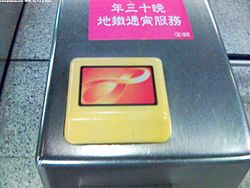
A Hong Kong, ils ont eu la même idée, ça s'appelle l'Octopus Card:

Aujourd'hui, on compte plus de 10 millions de cartes actives (rappel: il y a 7 millions d'habitants dans le pays), effectuant 8 millions de transactions quotidiennes, et stockant un solde cumulé de 50 millions d'euros. Un certain succès quoi....
Usages: métro, train, bateau, supermarché, 7-eleven, distributeurs de canettes (finit le "t'as pas 5 centimes?"), cabines téléphoniques, photomatons, parking, starbuck, circle K, Mc Donald's, etc.



Lecteurs de carte à mcdo, au métro, dans un bus
Un outil indispensable, d'autant plus que nous autres étudiants disposons de 50% de réduction pour le métro et le train grâce à nos octopus spéciales :)
Et pour finir en beauté, un petit paragraphe technico-geek qui va vous expliquer la magie de l'octopus card plus en détail:
The Octopus system was designed by Australia-based company ERG Group. The company was selected in 1994 to lead the development of the Octopus project and was responsible for the building and installation of the components of the Octopus system.[53] Operations, maintenance and development was undertaken by Octopus Cards Limited, and in 2005, it replaced the central transaction clearing house with its own system.[6]
The Octopus card uses the Sony 13.56 MHz FeliCa radio frequency identification (RFID) chip,[54] and Hong Kong is the home of the world's first major public transport system using this technology.[55] This is a "touch and go" system, so users need only hold the card in close proximity of the reader, and thus physical contact is not required. Data is transmitted at up to 212 kbit/s (the maximum speed for Sony FeliCa chips), compared to 9.6 kbit/s for other smart card systems like Mondex and Visa Cash.[55] The card has a storage capacity of 1 KB to 64 KB compared to the 125 bytes provided by traditional magnetic stripe card.[56]
Octopus uses a nonstandard system for RFID instead of the ISO 14443 standards, since there were no standards in the nascent industry during its development in 1997. The operating range of the reader/writer is between 30 and 100 mm (1.18 and 3.94 in) depending on the type of model being used.[19]
Octopus is specifically designed so that card transactions are relayed for clearing on a store and forward basis, without any requirement for reader units to have realtime round-trip communications with a central database or computer.[57] The stored data about the transaction may be transmitted by network after hours, or in the case of offline mobile readers may be retrieved by a hand held device, for example a Pocket PC.
In practice, different data collection mechanisms are used by different transport operators, depending on the nature of their business. The MTR equips its stations with local area networks that connect the components that deal with Octopus cards—turnstiles, Add Value Machines, value-checking machines and customer service terminals. Transactions from these stations are relayed to the MTR's Kowloon Bay headquarters through a frame relay wide area network, and hence onwards to the central clearing house system (CCHS) for clearing.[58] Similar arrangements are in place for KCR stations and for retailers such as 7-Eleven. Handheld devices are used to scan offline mobile readers, including those installed on minibuses. Buses either use handheld devices or a wireless system, depending on operator.[58]
The Octopus card uses encryption for all airborne communication and it uses two-way authentication based on public key infrastructure (PKI).[59] In other words, data communications to and from the card are only established when mutually authenticated security handshaking is verified followed by transfer of encrypted data. The Octopus card and system have never been successfully hacked.[59]




5 commentaires:
toujours ausi geek les mec ! c'est ca qui fait plaisir !
D'ailleurs ca me fait penser que Orange/bouygues/SFR lancent le même projet avec la coordination de Mastercard en france l'année prochaine 2 villes en test actuellement, paiment sans contacts avec carte a puce ou puce dans le téléphone portable, le prix s'affiche meme sur l'ecran lol ^^
On arrete pas le progres mais la dessus HK et le Japon on deja 10ans d'avance sur nous autre froggy...
En même temps en France à part dans les grandes surfaces et aux restos, la CB ne sert pas souvent physiquement... Pour tout le reste il y a Paypal hein... m'enfin, truc de geek quoi ^^
love octopus !
mince
aucun rapport avec l'octopussy qu'on connait bien ... :(
deçu ...
Enregistrer un commentaire